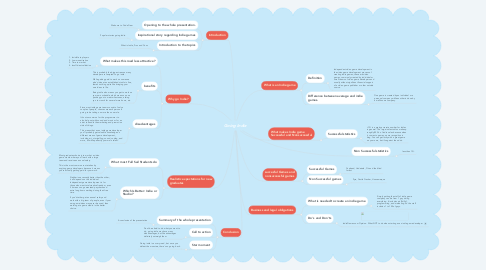
1. Why go Indie?
1.1. What makes this road less attractive?
1.1.1. 1. Invisible to players 2. Low monetization 3. Time to market 4. Insufficient validation
1.2. benefits
1.2.1. This is probably the biggest reason many developer are tempted to go indie. While getting paid to work on someone else’s idea at an established studio is fine, there’s nothing quite like bringing your own ideas to life. Being indie also means you get to work on your own schedule, which means no one pushing you to meet milestones, asking you to crunch for several more hours, etc.
1.3. disadvantages
1.3.1. Since most indie game teams consist of only a couple of people, chances are each person is going to be taking on more than one role. It’s not uncommon for the programmer to also help out with sound and music or for an artist to handle the marketing and promotion side of things. This means that as an indie game developer you’ll probably get valuable knowledge on different areas of game development, including art, storytelling, sound, coding, and more, all while perfectly your main talent.
2. Realistic expectations for new graduates
2.1. What most Full Sail Students do
2.1.1. Most graduates choice is to work at a video game studio where you’ll work with a large team and receive an annual salary. This is the most common route taken by aspiring game developers because it means you’re actually getting paid for your work.
2.2. Which Is Better: Indie or Studio?
2.2.1. Neither is necessarily better than the other; it all depends on the individual. Independent game development is for those who want total creative freedom, even if it means no guaranteed paycheck and extra long hours working during their free time. If you’d rather get an annual salary and work with a big team of people, even if your own game ideas may never be used, then working at a game studio is the better choice.
3. Introduction
3.1. Opening to the whole presentation.
3.1.1. Welcome to Code Gear
3.2. Inspirational story regarding Indie games
3.2.1. Popular stories going Indie.
3.3. Introduction to the topics
3.3.1. What is Indie, Pros and Cons
4. Conclusion
4.1. Summary of the whole presentation
4.1.1. A conclusion of the presentation
4.2. Call to action
4.2.1. Don't be afraid to do what you want to do, going indie may have many disadvantages, but the advantages definitely outweigh them.
4.3. Star moment
4.3.1. Going indie is a scary road, but once you defeat the monsters, there's no going back.
5. Non Successful statistics
5.1. less than 1%.
6. What is an Indie game
6.1. Definition
6.1.1. Independent video game development is the video game development process of creating indie games; these are video games, commonly created by individual or small teams of video game developers and usually without significant financial support of a video game publisher or other outside source.
6.2. Difference between average and indie games.
6.2.1. One game is created by an individual or a personal company while another is done by a well known company.
7. What makes Indie game Successful and Nonsuccessful
7.1. Successful statistics
7.1.1. >1% is a pretty accurate number for Indies in general. The large indie studios make up roughly 80%+ of indie sales because when it comes to games, name recognition is king. You can get lucky with a great game on your own, but it’s against the odds.
8. succesful Games and nonsuccessful games
8.1. Successful Games
8.1.1. Cuphead, Undertale, Ori and the blind forest
8.2. Non Successful games
8.2.1. Pyre, Castle Crasher, Housemarque
9. Business and legal obligations
9.1. What is needed to create an indie game
9.1.1. Simply putting the staff of indie game company can be from 1 guy doing everything. It includes art (2d-3d), programming, and marketing. So the staff includes 1 to 100 of guys.
9.2. Do's and Don'ts
9.2.1. IndieGames.com Opinion: What NOT to do when starting as an indie game developer

